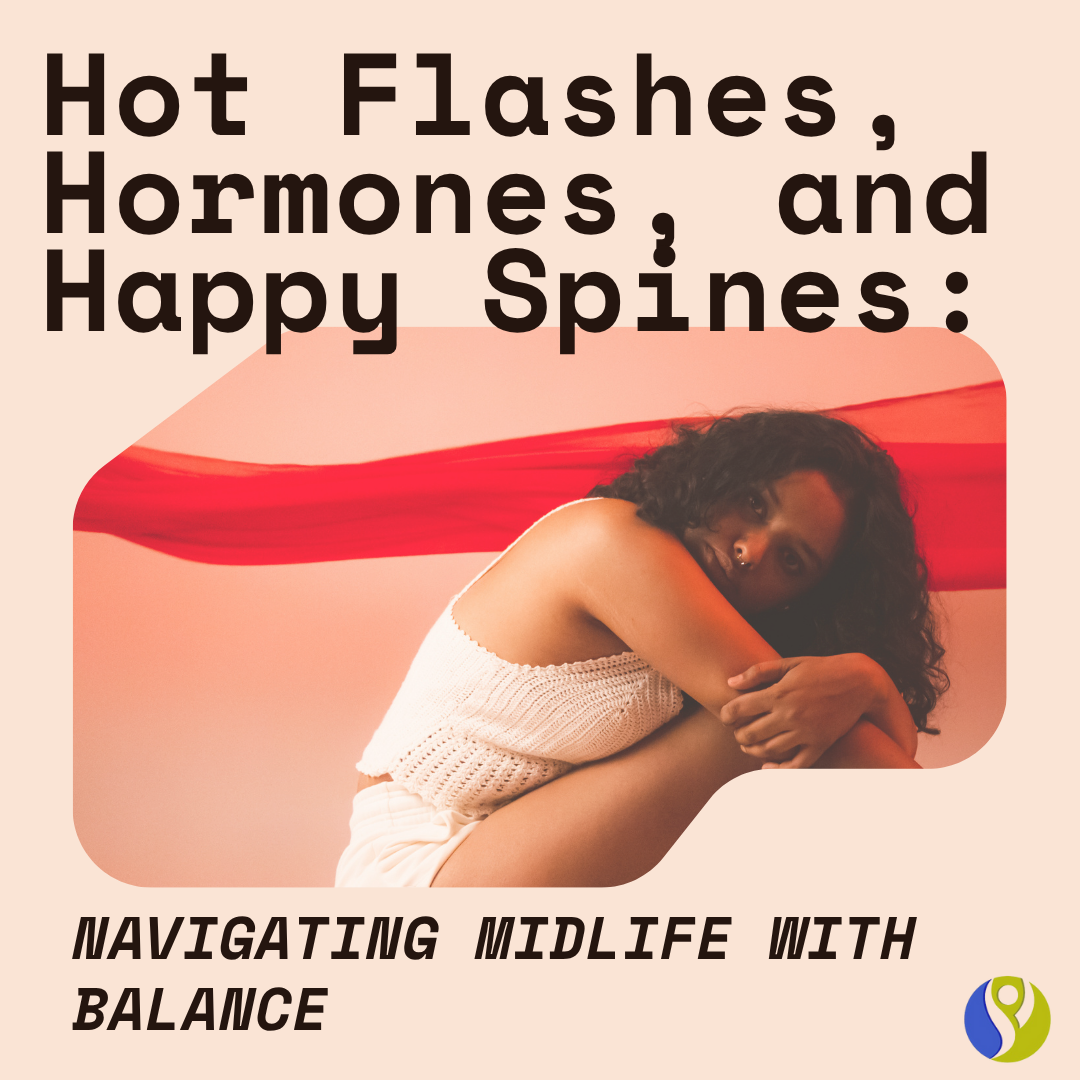Hot Flashes, Hormones, and Happy Spines: Navigating Midlife with Balance
🌸 The Midlife Rebrand: What’s Really Happening in Perimenopause and Menopause
There’s a moment (or, let’s be honest, several moments) when a woman realizes her body has started whispering,
“We’re under new management.”
Welcome to perimenopause and menopause, a natural biological transition marking the gradual decline of ovarian hormone production. According to the National Institute on Aging (NIA), menopause officially begins 12 months after a woman’s last menstrual period, typically between ages 45 and 55.
But perimenopause — the years leading up to it — can begin even earlier.
Common experiences?
Irregular periods
Hot flashes and night sweats
Sleep disturbances
Mood changes
Weight redistribution (hello, midsection)
Joint stiffness and muscle tension
All of these stem from fluctuating estrogen and progesterone levels, which affect not only reproductive tissues but also the nervous system, musculoskeletal health, and pain sensitivity (Menopause, 2020).
🔬 What Science Says About Hormones and the Musculoskeletal System
Estrogen isn’t just about fertility; it’s also a bone and joint protector.
When estrogen declines, so does bone mineral density and collagen integrity, contributing to an increased risk of:
Osteoporosis
Muscle fatigue
Stiffness and back pain
A review in the journal Frontiers in Endocrinology (2021) found that estrogen deficiency accelerates musculoskeletal aging, affecting posture, balance, and spinal health.
This is where chiropractic care and movement-based therapies can play a key supporting role.
💆♀️ How Chiropractic Supports Women in Midlife
Research is increasingly recognizing the connection between spinal function, nervous system regulation, and hormonal balance.
While chiropractic does not “treat menopause,” it can significantly improve quality of life by addressing common physical and stress-related symptoms that accompany the hormonal transition.
🩺 Reducing Musculoskeletal Pain
A randomized controlled trial in Spine Journal (2018) found that spinal manipulation therapy (SMT) can effectively reduce chronic neck and back pain — symptoms that tend to worsen with estrogen decline and sedentary habits.
🌿 Improving Sleep and Stress Regulation
Menopause often brings sleep disruption due to hormonal and autonomic changes.
By improving spinal mobility and reducing pain, chiropractic adjustments can enhance parasympathetic tone, supporting better rest and recovery (J Altern Complement Med, 2021).
💪 Enhancing Mobility and Posture
Core stability and spinal alignment play major roles in balance and fall prevention — both of which become increasingly important after menopause as bone density declines (Osteoporos Int, 2020).
🧘 Supporting Nervous System Adaptability
Chiropractic adjustments influence proprioceptive input and neuroplasticity, helping the body better adapt to environmental and physiological stressors, including hormonal fluctuations (J Manipulative Physiol Ther, 2019).
🍎 Holistic Tips for a Smoother Transition
Move Daily
Resistance training and weight-bearing exercise help maintain bone strength and boost mood.Eat for Hormone Health
Focus on omega-3 fats, leafy greens, and phytoestrogen-rich foods (like flaxseed and soy).
Limit refined sugar. Blood sugar swings may worsen hot flashes.
Hydrate Like You Mean It
Estrogen drop = less water retention. Your cells are thirstier now.Mind the Mind
Meditation, breathwork, and mindfulness practices reduce cortisol, a known antagonist to estrogen balance.Get Adjusted Regularly
Even subtle spinal restrictions can amplify stress signals and muscular tension, compounding hormonal discomforts.
💬 Real Talk: Why This Matters
Perimenopause and menopause aren’t signs of decline; they’re signs of transformation.
Your physiology is simply recalibrating, and chiropractic can be part of a holistic toolkit that supports your body’s adaptability through that change.
Think of it this way:
Your hormones may be shifting, but your health potential isn’t expiring. It’s evolving.
🧾 References
National Institute on Aging. Menopause Basics. NIH.gov.
Ma J, et al. “The impact of estrogen deficiency on musculoskeletal aging.” Front Endocrinol (Lausanne). 2021;12:702839.
Goertz CM, et al. “Patient outcomes following chiropractic care for chronic pain.” Spine J. 2018;18(11):1969–1980.
Taniguchi J, et al. “Effects of spinal manipulation on sleep and stress biomarkers.” J Altern Complement Med. 2021;27(3):228–235.
Compston JE. “Bone and menopause: mechanisms and management.” Osteoporos Int. 2020;31(2):203–220.
Haavik H, Murphy B. “The neurophysiological effects of spinal manipulation.” J Manipulative Physiol Ther. 2019;42(1):1–10.
🌿 Closing Thought
Women deserve education, empowerment, and evidence-based care that honors the connection between the spine, hormones, and whole-body health.





